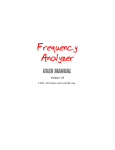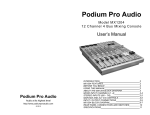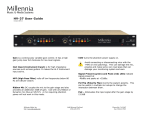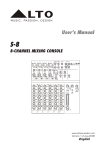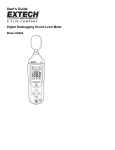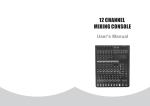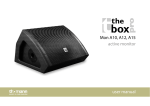Download MX602 User`s Manual
Transcript
Podium Pro Audio Model MX602 6 Channel 2 Bus Mixing Console User’s Manual Podium Pro Audio Audio at its highest level http://www.podiumproaudio.com © 2010 INTRODUCTION MX602 FEATURES BEFORE YOU BEGIN USING THIS MANUAL ABOUT THE MX602 BLOCK DIAGRAM MONO MIC / LINE INPUT CHANNELS (1 - 2) STEREO INPUTS (3/4 – 5/6) MAIN SECTION INPUT / OUTPUT CONNECTIONS MONO MIC / LINE CONNECTIONS AND CONTROLS STEREO INPUT CONNECTIONS AND CONTROLS MX602 BLOCK DIAGRAM INSTALLATION CONNECTOR WIRING SPECIFICATIONS 2 2 2 2 2 3 3 3,8 3,9 4 5 6-7 10 10 11 INTRODUCTION SPECIFICATIONS The Podium Pro Audio MX602 audio mixing console brings premium quality audio processing circuitry into the compact desktop class of mixers. Carefully designed signal routing, phantom microphone power, fully balanced design and versatile effects loops allow this console to provide class leading performance and flexibility. Used in accordance with the information provided in this manual, this product will give years of trouble free use. MICROPHONE INPUTS: Balanced XLR. PIN 1:ground, PIN 2:(+) PIN 3:(-) Frequency Response: (±2dB) <20Hz to 50kHz Distortion (THD+N): 0.01% at +4dBu, 1kHz Gain: Adjustable, +10dB to +60dB Signal-to-Noise ratio: 114dB Equivalent Input Noise: (20Hz to 20kHz) Source impedance = 0Ω: -132dB Source impedance = 150Ω: -129dB Distortion: (THD+N) 0.005%/0.004% A-weighted MX602 FEATURES • • • • • Two studio grade “Invisible” ultra low noise microphone (MIC) preamps Two balanced line inputs Two balanced stereo inputs (four mono) Direct-coupled signal processing. Rugged steel construction provides superior noise shielding. BEFORE YOU BEGIN • • • • • • • Read and follow these instructions. Heed all warnings. Do not use where the mixer may get wet. Never defeat the AC polarizing or safety ground on the AC cord. Be certain all equipment is OFF before making or breaking connections. Clean console only with a damp (not wet) cloth. Refer all service needs to qualified personnel. There are no user serviceable components inside. USING THIS MANUAL A basic understanding of what a mixing console does is very important. On the next page the console is filtered down to logical function “blocks”, and their use is summarized. Following the summaries you will find detailed descriptions of all controls and connections. ABOUT THE MX602 BLOCK DIAGRAM A block diagram is a simplified schematic which illustrates signal flow from input to output and shows the numerous routing variations possible. It is highly recommended that you make frequent use of the block diagram to get the most out of your MX602 mixer. You will find the MX602 block diagram on pages 6 and 7. Throughout this manual, you will frequently see the opamp symbol. . . h This indicates that understanding the current topic will be much easier if you review the block diagram. 2 MONO LINE INPUTS: Balanced ¼” phone jack. TIP:(+) RING:(-) SLEEVE:ground Frequency Response: (±2dB) <20Hz to 50kHz Distortion (THD+N): 0.01% at +4dBu, 1kHz Gain Range: +10dBu -40dBu STEREO INPUTS: Balanced ¼” phone jacks. TIP:(+) RING:(-) SLEEVE:ground Frequency Response: (±2dB) <20Hz to 50kHz Distortion (THD+N): 0.01% at +4dBu, 1kHz ALL EQUALIZERS LOW: ± 15dB @ 80Hz, shelving, MID: ± 15dB @ 2.5kHz, HI: ± 15dB @ 12kHz, shelving AUX SENDS: Unbalanced ¼” phone jacks. TIP:(+) SLEEVE:ground Output impedance: ≈120Ω Maximum output level: +22dBu MAIN OUTPUTS: Unbalanced ¼” phone jack. TIP:(+) SLEEVE:ground Maximum output level: +22dBu Signal to noise ratio: 112dB Equivalent input noise: -90dBu (all channels open, unity gain) CONTROL ROOM OUTPUTS: Unbalanced ¼” phone jacks. TIP:(+) SLEEVE:ground Maximum output level: +22dBu Signal to noise ratio: 112dB Equivalent input noise: -90dBu (all channels open, unity gain) POWER CONSUMPTION: 120VAC, 18W DIMENSIONS: H=50mm (2”) W=170mm (6-5/8”) D=215mm (8.5”) Weight: 1.2kg (2-5/8lbs) With power supply: 1.9kg (2-1/4lbs) 11 INSTALLATION • • MONO MIC / LINE INPUT CHANNELS (1 - 2) DETAILS ON PG 4 There are two identical MONO input channels located on the left of the console. These channels are organized vertically. At the top is an XLR microphone (MIC) input jack. 48V “phantom” power is available for condenser MICs. Next is a ¼” Tip Ring Sleeve (TRS) line level (LINE) input phone jack. Each MONO channel can be used as either a MIC or LINE input. The other controls provide a wide variety of sound shaping, signal routing, external processing and gain adjustments. The MX602 is designed for indoor use. Never use in a location where the unit may get wet. NEVER defeat the safety ground provision of the IEC power cord. NEVER USE A B AL ANCED TO UNB AL ANCED AD APTER I N EI THER MICROPHONE INPUT! THE MICROPHONE AND/ OR THE 48V “PH AN TOM” SUPPLY M AY BE D AM AG ED! STEREO INPUTS (3/4 - 5/6) CONNECTOR WIRING You will need many cables to complete the installation. Many more will be required for signal patching during sessions. Pre-fabricated cables may not always fit your needs and sometimes onsite repairs are necessary. The following illustrations show the correct connector wiring. DETAILS ON PG 5 There are two STEREO inputs (4 mono channels). The line level inputs are balanced ¼” TRS phone jacks. These channels are organized just like the “MONO MIC/LINE” channels and have the same controls and capabilities. However, no MIC inputs are provided. MAIN SECTION DETAILS ON PG 8 After all sources have been selected, equalization set and effects loops created, all signals are summed onto the LEFT/RIGHT MAIN bus and/or the AUX bus. There are numerous routing options from this point forward. Here, you will find controls for the “MAIN MIX” level, AUX return level and “PHONES/CONTROL ROOM” level. INPUT / OUTPUT CONNECTIONS DETAILS ON PG 9 Here you will find all remaining input and output connections. This is where the MX602 interfaces with the rest of the studio. 10 3 MONO MIC / LINE INPUT CONNECTIONS AND CONTROLS INPUT / OUTPUT CONNECTIONS ① MIC INPUTS (1 - 2) Ⓐ MAIN OUTPUTS Microphone input jack (balanced XLR) PIN 1: ground, PIN 2: (+) signal, PIN 3: (-) signal Phantom +48VDC supply: PINS 2 and 3 (when activated) η Ribbon, condenser and dynamic microphones are accommodated. NEVER USE A BALANCED-TO-UNBALANCED ADAPTER IN EITHER MICROPHONE INPUT! THE MICROPHONE AND/OR THE 48V “PHANTOM” SUPPLY MAY BE DAMAGED! ¼” phone jacks (unbalanced TS). The MAIN MIX signals are available here. Ⓑ CONTROL ROOM OUTPUTS L and R ¼” phone jacks (unbalanced TS). Normally used to provide line level signal to the monitor speakers in the control room. ② LINE INPUTS (1 - 2) Balanced line level input, ¼” phone jack (TRS) TIP: (+) signal, RING: (-) signal, SLEEVE: ground Any line level source (balanced or unbalanced) can be inserted here. Ⓒ PHONES Rotary microphone or LINE input sensitivity control. Use to set the level of this channel relative to other inputs. Thus creating the desired “mix”. Do not use as a fader. ¼” phone jack (unbalanced stereo TRS). You can connect monitoring headphones here. This output is the same signal as the CONTROL ROOM Ⓑ outputs. ④ HI EQ Ⓓ TAPE OUTPUT ③ GAIN Adjusts high frequencies up or down. Set to 0 (center detent) for no EQ. Unbalanced phono jacks (RCA). ⑤ MID EQ Wired in parallel with the MAIN OUTPUTS Ⓐ. Normally connected to the inputs of a 2track recording device. Adjusts mid frequencies up or down. Set to 0 (center detent) for no EQ. ⒺTAPE INPUT ⑥ LOW EQ Adjusts low frequencies up or down. Set to 0 (center detent) for no EQ. ⑦ AUX η Adjusts the signal level sent to the AUX 1 bus. This control is post “LEVEL”. This means “LEVEL” adjustments will also change the signal level being sent to the AUX 1 bus. ⑧ PAN Adjusts the relative position of the sound across the “stage” (left/center/right). ⑨ PEAK LED Unbalanced phono jacks (RCA). Normally used for a 2-track recording device input. “TAPE INPUT” can also be used as an additional stereo line level input. For example, additional sound elements can be added to the mix from a CD player, iPod, MP3 player or computer. Ⓕ STEREO AUX RETURN η Balanced line level input, ¼” phone jack (TRS). The “STEREO AUX RETURN” signal is added to the LEFT/RIGHT bus. If only the LEFT input jack is used the signal is sent to both LEFT and RIGHT channels. (MONO) Ⓖ AUX SEND η ¼” phone jack (unbalanced TS). The sum of all signals applied to the AUX bus are output here. NOTE: All feeds to the AUX bus are POST-“LEVEL”, also known as “wet”. This red LED lights when the input signal is too high. Lower input “GAIN” ③ or source level when this occurs. ⑩ LEVEL This is a compact mixing console. To reduce the console size, rotary knobs are used in place of the familiar slider. The function of the “LEVEL” control is the same as a linear FADER. Use the “LEVEL” control to “fade” the channel in or out during the performance. Normally this control should be at the 12:00 position, This is not a volume control. 4 9 MAIN SECTION STEREO INPUT CONNECTIONS AND CONTROLS ① MAIN MIX LEVEL η All signals sent to the LEFT and RIGHT MAIN bus are combined and sent to the MAIN OUTPUTS. This control adjusts the LEFT/RIGHT MAIN OUTPUT level. ② AUX RETURN LEVEL η The “STEREO AUX RETURN” is added to the LEFT/RIGHT bus. This control adjusts the level of the “STEREO AUX RETURN” signal added to the LEFT/RIGHT bus. ① LINE IN 4/5 – 5/6 (L) Balanced line level input, ¼” phone jack, Tip Ring Sleeve (TRS). LEFT channel. NOTE: When only the “L” input jack is used, the signal is routed to both left and right channels (MONO). η LINE IN 4/5 – 5/6 (R) Balanced line level input, ¼” phone jack (TRS). RIGHT channel. ② HI EQ ③ PHONES / CONTROL ROOM LEVEL Adjusts the level of the signal applied to the control room and headphone outputs. Adjusts high frequencies up or down. Set to 0 (center detent) for no EQ. ④2TK TO MAIN MIX (2 Track to Main Mix) Press to send the TAPE input directly to the LEFT/RIGHT bus (MAIN MIX). Typically used for playback monitoring or adding pre-recorded elements to the mix. Adjusts mid frequencies up or down. Set to 0 (center detent) for no EQ. ⑤ 2TK TO CTRL ROOM (2 Track to Control Room) Press to send the TAPE input directly to the CONTROL ROOM AND HEADPHONE outputs. Typically used for real-time tape monitoring without disturbing the ongoing performance. ⑥ +48V Condenser microphones require an external power supply to operate. Depressing this switch activates an industry standard 48V “phantom” supply. • When the phantom supply is on, +48V is applied to both of the microphone connectors. You may use either dynamic or condenser microphones while the “phantom” power is on. • NEVER use a balanced XLR to unbalanced ¼” phone adapter when the phantom power is on! ⑦ +48V LED This blue LED lights whenever the 48-volt microphone phantom power is on. ⑧ POWER LED This red LED lights whenever the console is on. The MX602 is on whenever the external power supply is connected to the console and plugged into a wall outlet. ⑨ LED VU METER These LEDs indicate the signal level of the MAIN MIX. For best results, avoid operation above 0dB. Occasional flashing of the +6dB LED may be allowable but operation with the “CLIP” LEDs flashing must be avoided. 8 ③ MID EQ ④ LOW EQ Adjusts low frequencies up or down. Set to 0 (center detent) for no EQ. ⑤ AUX η Adjusts the signal level sent to the AUX bus. This control “AUX” is after, or POST “LEVEL” ⑦. This means “LEVEL” adjustments will also change the signal level being sent to the AUX bus. ⑥ BAL Adjusts the relative LEFT / RIGHT signal level (BALANCE) applied to the LEFT/RIGHT MAIN bus. ⑦ LEVEL This is a compact mixing console. To reduce the console size, rotary knobs are used in place of the familiar slider. The function of the “LEVEL” control is the same as a linear FADER. Use the “LEVEL” control to “fade” the channel in or out during the performance. Normally this control should be at the 12:00 position, This is not a volume control. 5 Podium Pro Audio 6 MX602 BLOCK DIAGRAM 7









